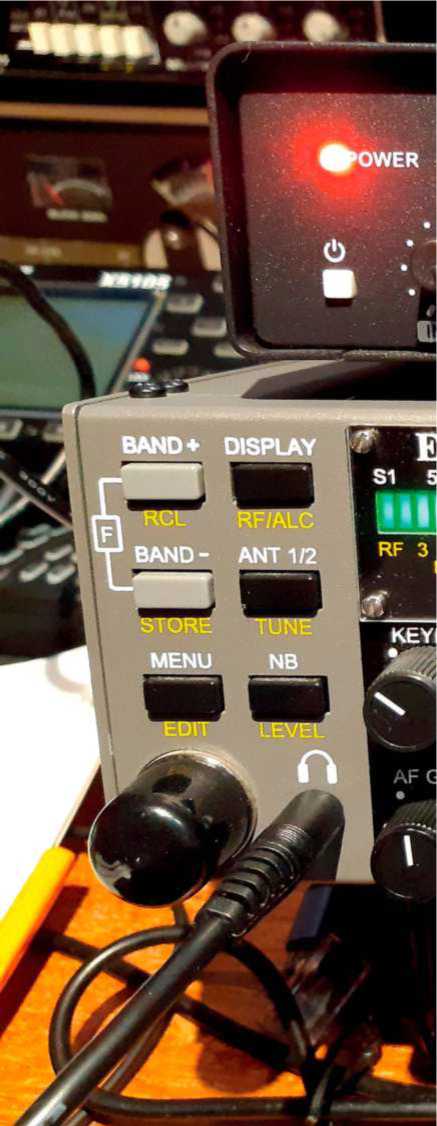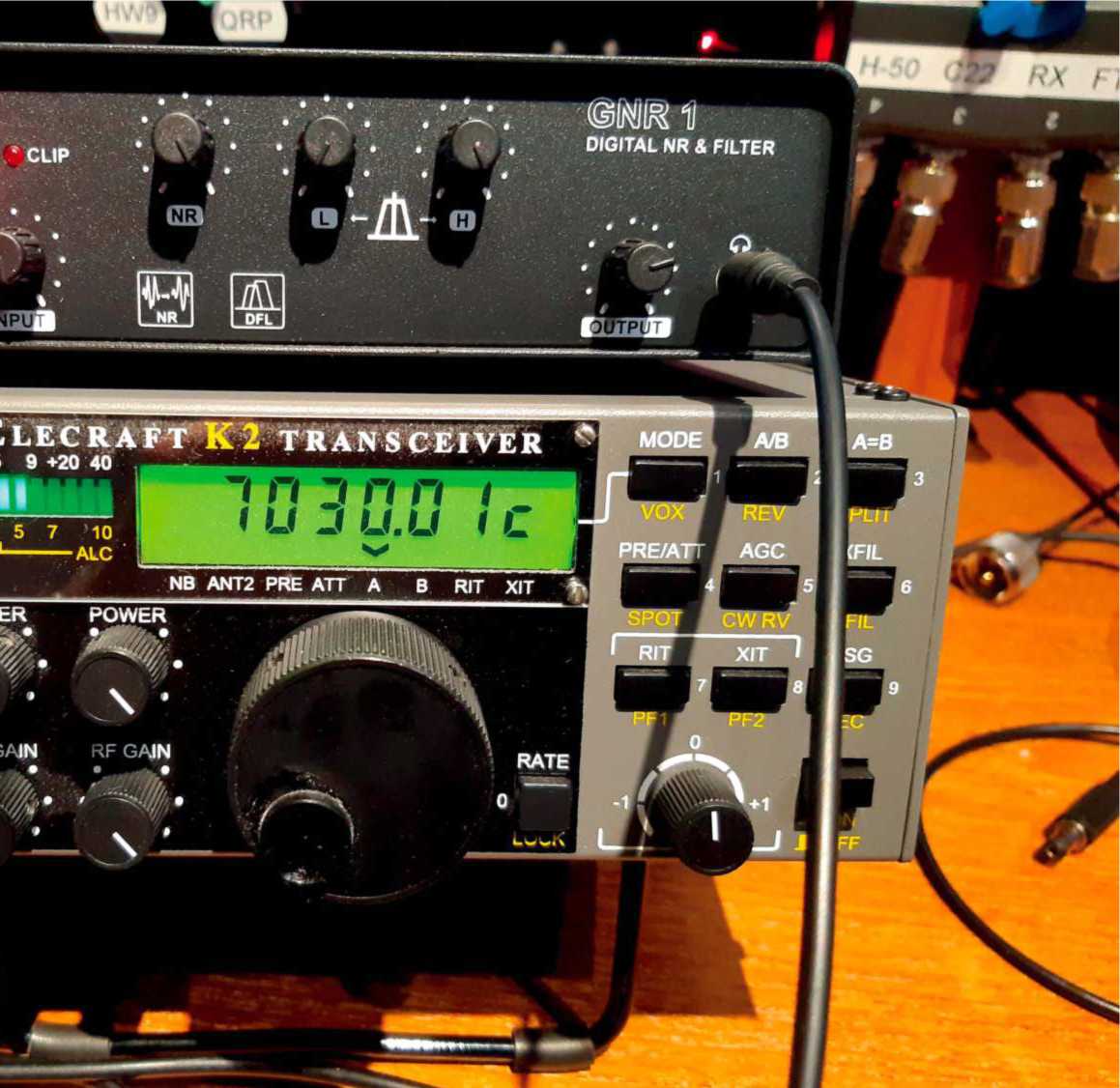Xiegu GNR1 Review

Daimon Tilley G4USI checks out a newly launched accessory from Xiegu. Read our Xiegu GNR1 Review.

Pleased to see another new product from Xiegu, Alan at Sinotel kindly agreed to the loan of this device to review.
The blurb states that the filter is designed to be used in the external audio chain of a transceiver or receiver to effectively reduce background noise, improve signal-to-noise ratio (SNR) and improve the ability to resolve signals.
Description
Arriving well packaged, the filter itself is housed in a sturdy metal case, which is black and looks very professional. Dimensions are 159 x 44 x 143mm. On the front are a power switch, audio input level control, a noise reduction control, controls for Low and High Cut and an output control. Also on the front panel is a 3.5mm headphone jack, a power LED and an LED to indicate clipping, which can then be rectified using the line input control. However, even with the maximum setting of this control and a decent volume from the transceiver or receiver, it never clipped for me.
On the rear panel is a 12V coaxial power input, a 3.5mm Line In socket, a High/Low Line In impedance switch, and two speaker outputs, giving a choice of phono or 3.5mm jack.
Also included in the box is a lengthy 3.5mm double-ended stereo cable and a 12V wall-wart power supply with the correct plug for the device. Disappointingly, like the X6100 transceiver, this plug is a Euro plug and will need to be used with a three-pin adapter, which is not supplied. For this reason, I used my shack 13.8V supply. The manual states a supply of 12V with a tolerance of plus or minus 15%. There is a highlighted warning not to use it under-voltage, although I am not clear why.
In practice I found that the Line In could be taken from either the external loudspeaker or headphone socket of the rig it is coupled with. The manual sounds a note of caution at this point, noting that all 3.5mm sockets must be used with a stereo, and not mono connector, to prevent internal damage.
The specifications claim that the noise reduction can achieve more that 22dB of reduction and the Low Cut range is 5Hz-1280Hz, with High Cut ranging from 500Hz- 5615Hz. These ranges should allow use with AM broadcast stations, through to SSB and CW signals. Output from the unit can be sent to either to a speaker with impedance between 4 – 16 ohm, or to headphones in the impedance range 16 – 640.
Testing
I decided to test the device with my Kenwood R1000 receiver and my recently acquired Elecraft K2 transceiver. In the case of the R1000, the filtering is quite wide, making AM and SSB reception comfortable but CW reception on a busy band very difficult – the filters are just too wide and this is where I started. Connecting the GNR1 to the external speaker output of the receiver I began with the Noise Reduction. This was seriously impressive. There was a large amount of band noise on a couple of the evening tests and the GNR1 progressively killed it stone dead! Just a small initial tweak of the control made a big difference, but then the effect could be improved right through the range. Signals that were surrounded by noise were suddenly isolated and clear with the noise just falling away. Understandably, and as pointed out in the manual, there was a need to increase the unit’s audio output as a result, but this worked well.
Moving to the CW portion of the bands, and with the R1000 only tuning in 1kHz steps as well as having wide filters, CW reception has always been tough. Using the Low and High Cut controls together seemed to work well and allowed quite reasonable isolation of what were otherwise conflicting signals. I think this would have been easier if the receiver tuning resolution was better, but we work with what we have and the GNR1 did help a lot. It didn’t make the R1000 the perfect CW receiver, but it definitely made it much more usable. On SSB I struggled to see much benefit from the Hi and Low Cut filters on the R1000 if I am honest.
I then moved to the K2. The CW filtering on the K2 is excellent, going down as low as 100Hz, so I saw no benefit in testing this. The K2 also has quite effective noise reduction but I was keen to see what the GNR1 could bring to the party. I played around comparing the NR on both devices. While the K2’s noise reduction is quite effective, it is either on or off, not variable, and it does produce some quite hollow artefact sounds, which can be a little annoying at times. Switching in the GNR1 was just as impressive an improvement as it was on the R1000. The noise merely fell away by degrees as I adjusted the control, compensating for the slight loss of audio by increasing the Line Out control. It was much more effective than the K2 on its own.
Listening on SSB on the K2, the NR was again more effective than that of the rig, but again I found the Low and High Cut to be of very limited use compared to the selectable rig filters. I then decided to see if the NR worked with RFI noise. I am lucky to live very rurally on a smallholding with no near neighbours and therefore a low noisefloor. However, I do possess a cheap Chinese Switched-Mode Bench Power Supply, which has its uses but is a hideous RFI generator! Switching it on while listening to the K2 on 40 or 80m gives me S9

of noise. The GNR1 handles it well, and made the difference between a comfortable and a difficult copy of medium strength stations.
When using the GNR1 Noise Reduction during transmit, I did find that immediately after finishing your transmission the noise on receive does increase before fading away to the reduced level very shortly afterwards, but this did not cause me a problem.
So, in essence, I found the Noise Reduction to be first class, and the Low and High Cut filtering effective on receivers (or transceivers) with wide CW filtering. On SSB, however, I struggled to identify any real benefits.
My only real wish is that the controls for filtering were slightly different. To make use of them I found you were constantly having to fiddle with both slope controls all the time, to eke out your desired signal and this was a little cumbersome for me personally. I cannot help but draw a comparison to my old Datong FL3 audio filter, which I use with my Heathkit HW9. The Datong does not have any Noise Reduction, but I do rate its ability as a CW filter very highly. It has a slightly different control setup which I prefer – namely there is a single control for bandwidth and then a separate control to shift the centre frequency of your passband. If the GNR1 had these controls, I do think it would be easier to use in the way I would want to use it. If I were to keep it, I would want to add a bigger series resistor to the power LED, which is somewhat blinding of a late evening, but this is being very picky!
Retailing from Sinotel at £ it could be a fabulous addition to your shack, particularly if, like me, you are a fan of older equipment, where it could really enhance your operating experience.